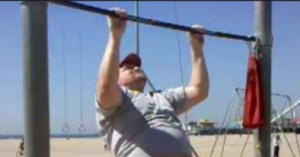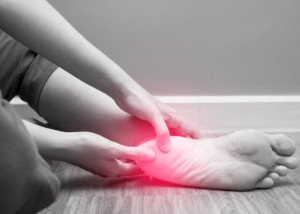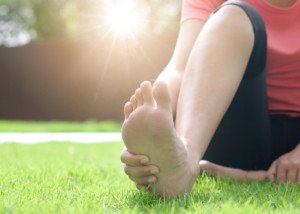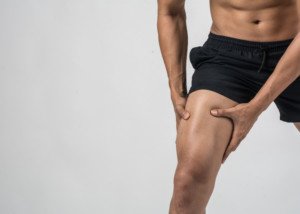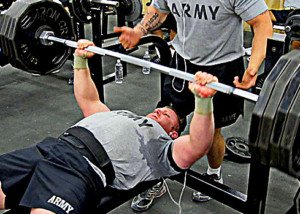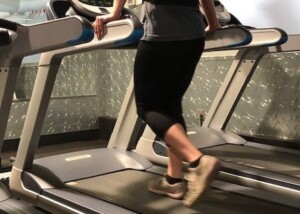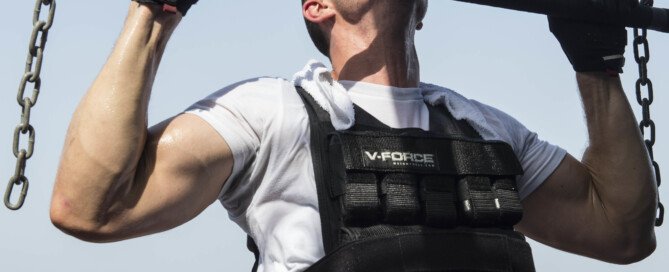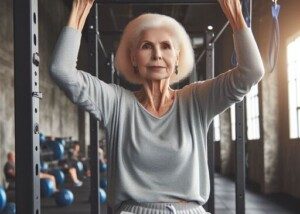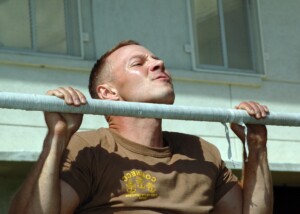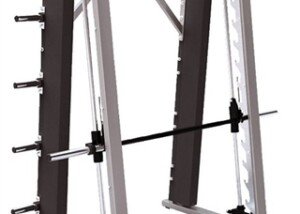Can You Lose Weight with Exercise Alone?
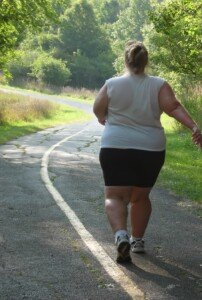
Yes, you can lose weight with exercise alone.
It’s actually a myth that you cannot lose weight with only exercise and no change to your diet. Losing weight happens when you create a calorie deficit.
Many times I have read articles stating that you cannot lose weight with just exercise. This is incorrect.
A calorie deficit can be created by just exercise, thereby causing weight loss. Look at this in reverse: a slender person who eats quite a bit, but hits the gym 90 minutes every day, and on weekends, goes on 40 mile mountain bike rides.
If this person were to quit exercising, yet not change his eating habits, he’d gain weight.
He then moves to another town, 15 pounds overweight, still not exercising, and asks a fitness professional if he can get slim by just exercise alone.
Chances are that the fitness professional, or even a physician, would say, “No, you cannot lose weight with just exercise.”
This person then resumes exercise, and the weight comes off.
The general consensus is that exercise alone will result in some weight loss, but not all the pounds that a person wishes to lose.
But this is false. It depends on how much weight the person needs to lose.
Let’s take a sedentary person, who eats 2,000 calories a day, and is 10 pounds overweight, who decides to take up strength training three times a week for 45 minutes and cardio training three times a week for 45 minutes.
If he works out with gusto, they will certainly lose all of those 10 pounds, and maybe even a few bonus pounds of fat.
It isn’t just the calorie deficit created by new physical activity that matters here.
It’s the faster resting metabolic rate that results from exercise if it’s intense enough.

hutterstock/wavebreakmedia
So if you burn an extra 300 calories a day strength training, for instance, your caloric deficit will be more than 300 calories a day, because strength training, especially if it’s intense, will cause you to burn more calories per hour even when you are at rest. This is called the after-burn effect.
Over time, a lot of fat can be lost, if the person goes from completely sedentary to very active, engaging in hormonal exercise and HIIT training.
The result will be many more calories burned every day, which will lead to pounds lost.
However, fat loss will be expedited if a person indeed changes their eating habits, and especially if their original eating habits consisted of huge quantities of food; this creates more room for a larger daily caloric deficit.
Conclusion
1) You can lose weight with exercise alone
2) Exercise alone may cause all the weight you want to lose to disappear, depending on how much you wish to lose, how you work out and how much you overeat.
Obviously, a 300 pound person needs to alter their diet to lose weight, but someone who wants to lose only 15 pounds and is sedentary may very well be able to rid this weight with a strength training and cardio program alone.
If they are already working out hard, then they will need to alter their diet.
3) The more weight you have to lose, the more you’ll need to change your eating habits to get the job done.
 Lorra Garrick is a former personal trainer certified by the American Council on Exercise. At Bally Total Fitness she trained clients of all ages for fat loss, muscle building, fitness and improved health.
Lorra Garrick is a former personal trainer certified by the American Council on Exercise. At Bally Total Fitness she trained clients of all ages for fat loss, muscle building, fitness and improved health.
The Best Cardio Machine for HIIT

The best cardio machine for HIIT is the one in which you can do the greatest variety of routines, while including impact.
The best cardio machine for HIIT is one in which all levels can reap rewards — including the abs you’ve always wanted.
It is the treadmill.
The treadmill not only provides impact, but for those for whom impact is not a smart idea, the treadmill can also provide a softer strike by slowly walking a steep incline.
The best machine for HIIT is definitely the treadmill because of the many permutations that can be done on it.
You can walk, skip and jump, as well as jog, run and sprint. You can go forwards or backwards, even sideways. And of course, you can add the incline.
Another reason that the treadmill is the best cardio machine for HIIT is because it most closely mimics real-life movement.
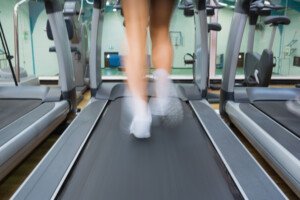
Shutterstock/wavebreakmedia
HIIT stands for high intensity interval training, and the truest definition of this form of training is alternating about 30 seconds of your hardest, most strenuous effort, with 2-4 minutes of a casual recovery pace.
The reason the intensity interval lasts no more than 30 seconds is because this is the time frame, 30 seconds or less, in which a person can sustain their absolute hardest effort.
If you can sustain a pace for longer than 30 seconds, then it isn’t your absolute all-out effort.
An example would be a 13 mph run on the treadmill. You may only be able to sustain this for 18 seconds.
This would be a great intensity interval. If you can run 13 mph for 38 seconds, then this would not be the most effective training interval.
What you would need to do is increase the speed of the treadmill, or add an incline, so that within 30 seconds, you have totally run out of steam and are left feeling hammered.
Some people believe that the best machine for HIIT is the stationary bike, because it is gentler on the joints, and if you have knee issues or plantar fasciitis, I recommend the stationary bike.
But for the average, “healthy” person, I say that the treadmill is the best machine for HIIT.
However, another great piece of equipment for high intensity interval training is the revolving staircase and the “Treadclimber.”
I explain to my clients why holding onto these machines, as well as the treadmill, is wrong, takes work away from the large muscle groups, is a bad cheating habit, and should only be done when you check heart rate or turn around momentarily, to prevent falling.
Otherwise, hands should be free, arms moving in unison with your lower body, the way you would be moving if walking, jogging, running, stepping or hill climbing outdoors.
Ultimately, the best cardio machine for HIIT is the one that you look forward to using the most. And this includes only your body!
 Lorra Garrick is a former personal trainer certified through the American Council on Exercise. At Bally Total Fitness she trained women and men of all ages for fat loss, muscle building, fitness and improved health.
Lorra Garrick is a former personal trainer certified through the American Council on Exercise. At Bally Total Fitness she trained women and men of all ages for fat loss, muscle building, fitness and improved health.
.
Top image: Shutterstock/George Rudy
Karate Board Breaking Tricks for Beginners

Are you a beginning karate student who’s been struggling to break boards?
I have many years’ experience in karate and other hard style martial arts like taekwondo. (more…)
Fast Plantar Fasciitis Treatment Without Surgery
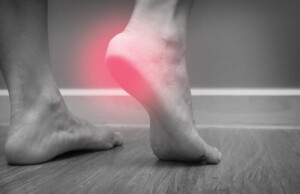
If you’ve tried conservative treatment for plantar fasciitis with no results, don’t give up.
There is a fast non-surgical treatment that, according to a study, has a 95 percent success rate at ridding the heel pain. (more…)
Treadmill HIIT vs. Elliptical Machine: Pros & Cons
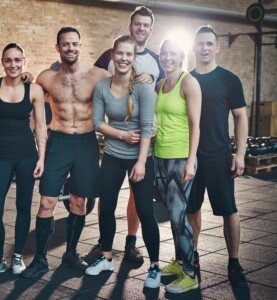
Which is better: HIIT with the elliptical or HIIT with the treadmill?
The best answer to which is better, elliptical HIIT or treadmill HIIT, begins with evaluating your goals. (more…)
The Best Barbell Routines for Obese Beginners
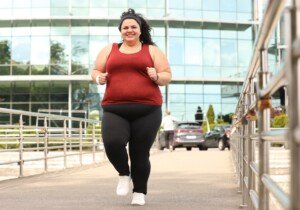
When an obese person starts working out with barbells, something magical happens: dramatic weight loss and a change in body shape. And isn’t that what you want? (more…)
Uphill Walking Tips for Overweight: Get Fit, Lose Weight
Whether uphill outside or on a treadmill incline, being overweight need not be an obstacle to getting fitter & leaner.
You can speed your progress with a technique called high intensity interval training—or its derivative, interval training.
I see overweight people walking uphill on long hiking trails, and they do a pretty good job of it.
Oddly, when I see overweight people using a treadmill incline, nearly 100 percent of them are holding on.
This will have zero carry-over to walking hills outside, and it will do very little for achieving their fitness and weight loss goals.
Tips for Walking Uphill Outside for Overweight Adults
• Make sure you’re broken into your athletic footwear; wear the shoes on neighborhood walks, for instance, before you take off on the trails, to screen for any blister development.
• Bring with you for the trail a bottle of water.
• Do not use walking sticks, ski poles or Nordic poles. These act as assistive devices and subtract work from your core, spine, hips, legs and feet.
• If you’re completely untrained for uphill walking, proceed as a thinner person would: Don’t try to do too much at once. Don’t try to tackle unstable terrain.
• Stay local, meaning, loop around hiking trails that are close to the trailhead rather than venturing further and further out.
Otherwise you may suddenly realize how fatigued you are—when you’re a mile from the trailhead.
Tips for Walking a Treadmill Incline for Overweight Adults
• Do not hold on. This is the biggest issue. I just can’t say it enough: Holding on unteaches your body ambulatory efficiency.
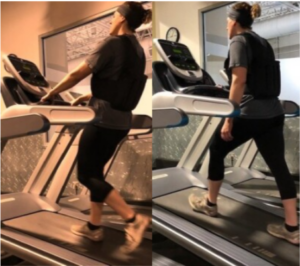
It’s common sense, not just science: Which walk looks more realistic for a hill?
• Holding on burns 20 percent fewer calories than walking hands-free. The calorie readout is not reliable; it’s triggered by the motor speed and incline setting, not the person on the machine.
• Focus on deep steady breathing and moving your arms in synch with your lower body.
Interval Training
The work interval is a brief period in which you’re walking faster than what’s comfortable, getting you winded.
The work interval lasts 10 seconds to a minute or more. If you’re going beyond several minutes, though, this won’t be as effective as if you moved faster for a briefer period.
Moving your absolute fastest over a 10 to 30 second period — and I mean your FASTEST, to the point where you’re really huffing and puffing at the end — is an intense version of interval training.
You’re so out of breath that it’s very uncomfortable to speak at the end of that 10 or 30 seconds.
With non-intense interval training, your movement is slower, allowing you to go beyond 30 seconds, but you can stop at 30 seconds, or even 15 — it’s just that at the end of this work interval, you’re not huffing and puffing, but you are still quite winded and feel like you really need to rest.
The rest interval should be one to several minutes of easy paced walking. If you’re on a hill outside, adjust this easy pace to correlate to the steepness.
So if the hill is really steep, go really, really slow, but do not stop. You may want to do switch-backs (walking diagonally back and forth as you slowly ascend) if there’s room on the trail.
With a treadmill, lower the incline and speed, or just the speed, whatever it takes so that the rest interval recovers you.
Final Tip for Uphill Walking for Overweight Men & Woman
Don’t right away jump into high inclines, as this will cause sore calves the next day.
In fact, your calves will probably burn right then and there. Always warm up.
Slow down and/or move to a milder incline or lower the treadmill grade, and remember, if you’re using a treadmill, do not hold on.
Overweight people who want to get fitter walking uphill can also join a hiking group.
 Lorra Garrick is a former personal trainer certified through the American Council on Exercise. At Bally Total Fitness she trained women and men of all ages for fat loss, muscle building, fitness and improved health.
Lorra Garrick is a former personal trainer certified through the American Council on Exercise. At Bally Total Fitness she trained women and men of all ages for fat loss, muscle building, fitness and improved health.
.
Top image: Shutterstock/DedovStock
Why Some Fat People Can’t Lose Weight Despite Diet & Exercise

Don’t blame “fat genes” if you’ve “tried everything” & still can’t lose weight.
There’s a humbling reason for your chronic weight loss failure. The good news is that you can solve this problem! (more…)
How to Make Walking Undo Obesity Genes and Burn Fat

Not just any ordinary walking can reverse the effect of an obesity predisposition, because the walking must be done with rhyme and reason.
A person may have a tendency to become overweight under certain circumstances, but this genetic hand can be played intelligently by a solid program of walking.
Researchers at the American Heart Association’s Epidemiology and Prevention/Nutrition, Physical Activity and Metabolism 2012 Sessions have a particular recommendation.
And that is to walk briskly for an hour every day. As a former personal trainer as well as lifelong exercise enthusiast, I can’t begin to tell you how many people I regularly see walking slowly on a treadmill, and holding onto it at that.
This kind of walking (if you want to even call it that) will not produce results.
Obese and overweight people can learn to walk briskly for sustained periods — on a treadmill and outdoors. Every once in a rare while, I see a quite hefty individual walking briskly or even jogging on a treadmill.

“While previous studies have looked at how physical activity affects genetic predispositions, this is the first study that directly looked at the effect of the sedentary behavior of television watching on the body mass index (BMI) of individuals with a genetic predisposition to obesity,” explains the study’s author, Qibin Qi, PhD.
Obesity has a genetic influence in that some people are more prone to developing obesity than others, under certain circumstances: eating large quantities of food and avoiding exercise.
However, with the right lifestyle choices, one does not have to become obese.
The study showed that a brisk walk of one hour a day reduced the genetic predisposition towards obesity – by a whopping one half, as measured by body mass index.
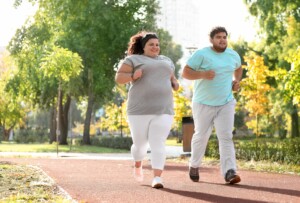
Shutterstock/New Africa
The obesity genetic influence was raised by 50 percent with four hours a day of watching TV.
The average U.S. person watches TV 4-6 hours a day. The irony is that sedentary people typically believe that two hours a day of exercise is excessive, even one hour a day.
What exactly is brisk walking? Unfortunately, this gets subjective. I’ve known people who believe they walk briskly, when in fact, they walk slowly.
A true brisk walk is between 3.5 and 4 mph on a flat course.
However, to an obese, sedentary person, a sustained 2.5 mph walk will be taxing and feel “brisk.”
Walk as fast as you can for one hour. If all you can do are 10 minutes nonstop before having to rest, then walk as fast as you can for 10 minutes.
Don’t shuffle or putter; really walk hard, pumping the arms. Forbid yourself from holding onto the treadmill if you prefer this equipment. Increase duration over time.
Do not count the walking you did at the mall as part of your walking exercise. Also do not count walking you did around the house while cleaning it, or on the job!
Set one hour aside daily for walking, even if you must break it down into six, 10-minute sessions.
Obesity will not go away on its own. Lifestyle choices can override the so-called obesity gene.
Don’t give the obesity gene power. The obesity gene is weaker than you think.
 Lorra Garrick is a former personal trainer certified through the American Council on Exercise. At Bally Total Fitness she trained women and men of all ages for fat loss, muscle building, fitness and improved health.
Lorra Garrick is a former personal trainer certified through the American Council on Exercise. At Bally Total Fitness she trained women and men of all ages for fat loss, muscle building, fitness and improved health.
.
Top image: Depositphotos.com
Source: sciencedaily.com/releases/2012/03/120314142833.htm
Pull-up Training for Mildly Overweight People: Yes, You Can!
